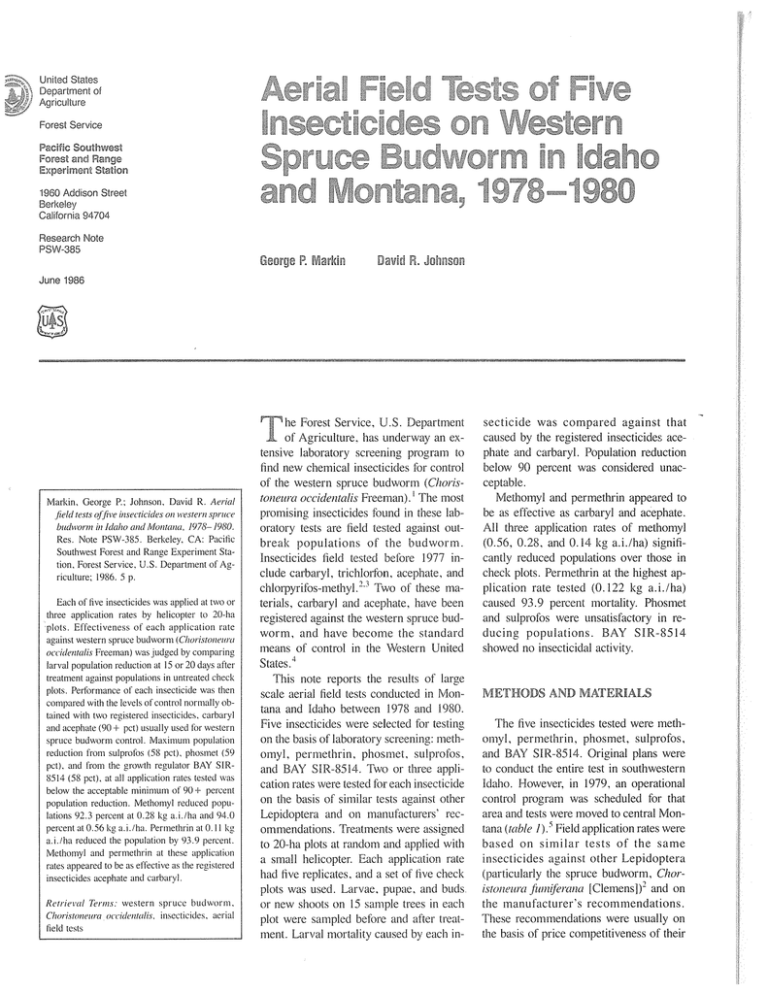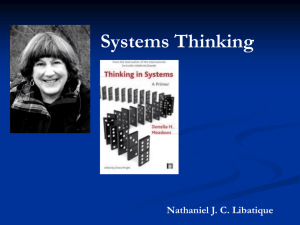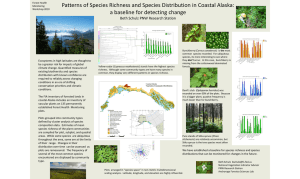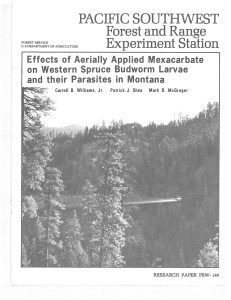Western 1978 Five of
advertisement

d Tests of Five
nsecticides on Western
Spruce Budworm in
and Montana, 1978
Forest Service
Pacific Southwest
Forest and Range
Experiment Station
1960 Addison Street
Berkeley
California 94704
Research Note
PSVV-385
George Pa Markin
David R. Johnson
June 1986
T
'
Markin. George P.: Johnson, David R. Aerial
j r l d rc7srsof've ii~secticidesoil ryesterr1sprrrcr
budnvorrn ill Icfc11foaild MOII~CIII~Z.
1978- 1980.
Res. Note PSW-385. Berkeley. CA: Pacific
Southwest Forest and Range Experinlent Station, Forest Service. U.S. Department of Agriculture; 1986. 5 p.
Each of five insecticides was applied at two or
three application rates by helicopter to 20-ha
plots. Effectiveness of each application rate
a~ainstwestern spruce budworni (Clroi~istoirer~rcr
occiel~irtc11i.s
Freeman) was judged by cornparing
larval population reduction at I5 or 20 days after
treatment against populations in untreated check
plots. Performance of each insecticide was then
compared with the levels of control normally obtained with two registered insecticides. carbaryl
and acephate (90 pct) usually used for western
spruce budworrn control. Maxiniuni population
reduction from sulprofos (58 pct), phosmet (59
pet). and from the growth regulator BAY SIR8514 (58 pet), at all application rates tested was
below the acceptable minimu~nof 90 + percent
population reduction. Methomyl reduced populations 92.3 percent at 0.28 kg a.i./ha and 94.0
percent at 0.56 k e a.i./ha. Permethrin at 0.11 kg
a.i.iha reduced the population by 93.9 percent.
Metho~nyland permethrin at these application
rates appeared to be as effective as the registered
insecticides acephate and carbaryl.
+
1 Rcrrirvcll
Grins: western spruce budworm.
Clzoi-i.srorrrrtm oc~cidc~irttrli.s.insecticides, aerial
field tests
he Forest Service, U.S. Department
of Agriculture. has underway an extensive laboratory screening program to
find new chemical insecticides for control
of the western spruce budworm (Clzoristoizeurn occiderzmlis Freeman). The most
promising insecticides found in these laboratory tests are field tested against outbreak populations of the budworm.
Insecticides field tested before 1977 include carbaryl, trichlorfon, acephate, and
chlorpyrifos-methyl.'.' Two of these materials, carbaryl and acephate, have been
registered against the western spruce budworm, and have become the standard
means of control in the Western United
states."
This note reports the results of large
scale aerial field tests conducted in Montana and Idaho between 1978 and 1980.
Five insecticides were selected for testing
on the basis of laboratory screening: methomyl, permethrin, phosn~et. sulprofos,
and BAY SIR-8514. Two or three application rates were tested for each insecticide
on the basis of similar tests against other
Lepidoptera and on manufacturers' recommendations. Treatments were assigned
to 20-ha plots at random and applied with
a small helicopter. Each application rate
had five replicates, and a set of five check
plots was used. Larvae, pupae, and buds
or new shoots on 15 sa~npletrees in each
plot were sampled before and after treatment. Larval mortality caused by each in-
/
secticide was compared against that
caused by the registered insecticide, acephate and carbaryl. Population reduction
below 90 percent was considered unacceptable.
Methomyl and permethrin appeared to
be as effective as carbaryl and acephate.
All three application rates of methomyl
(0.56, 0.28, and 0.14 kg a.i./ha) significantly reduced populations over those in
check plots. Permethrin at the highest application rate tested (0.122 kg a.i./ha)
caused 93.9 percent mortality. Phosmet
and sulprofos were unsatisfactory in reducing populations. BAY SIR-8514
showed no insecticidal activiiy.
METHODS AND MATERIALS
The five insecticides tested were methoniyl, permethrin, phosmet, sulprofos,
and BAY SIR-8514. Original plans were
to conduct the entire test in southwestern
Idaho. However, in 1979, an operational
control program was scheduled for that
area and tests were moved to central Montana (fable/).%ield application rates were
based on similar tests of the same
insecticides against other tepidoptera
(particularly the spruce budworm, Choristoizeidrn jutnlfemrza [~lernens])'and on
the manufacturer's recommendations.
These reconi~nendationswere usually on
the basis of price competitiveness of their
-
Year of
tesi
Foriiiiiialion
(pci a.i.1
ivlethoniyl
1978
Permeihrin
1979
Phosmei
1979
I.;annaie i
(24 pcl)
Pounce 3.2 ED
(38.4 pct)
fniidan I%
i 12 pci)
Imidsn lE
( I2 pci)
Solstar G
(@ pco
Wettable powdei(25 pci)
Wettable Powder
(25 pct)
Common
name
1980
Sulprofos
1080
BAY SiR-8514
1979
1980
material with registered insecticides iil operational use.
The total volume of spray applied was
9.3 Liha of final spray solutioi;. The exception was phosmet in 1980; because the
formulation available (Hmidan 1E) contained 0.12 kg a.i./L, an applied volume
of 14.07 Liha was needed to obtain the
highest application rate- 1.67 kg a.i.iha.
To retain the same treatnient parameters
for the three application rates tested that
year, the applied volunle of the two lower
application rates was also increased to 14.0
Liha.
Experiinental design and plot layout were the same for all iilsecticides
except the growth regulator BAY SIR8514, for which only three plois were
treated at two application rates. For each
insecticide, plots were selected at approximately the same altitude. bur located no
closer to each other than 1 knl to prevent
cross-containiilation by drift. Plots were
20 ha and usually rectangular. Tteatments
were assigned to the plots at random and
consisted of five replicates for each of the
three application rates tested plus a set of
five check plots.
Within each plot. 15 sarnple trees were
selected. Grand fir ( k b i e s gr-ntzdis
[Dougl.] Lindl.) was used in the tests in
Idaho, and Dougias-fir (Pseuciotsliga rxerrzic2sii variety gluuca [Beissil.] Franco) was
used in Montana. Sample trees were 10 to
20 m tall, open grown, and at least 30 percent of their bliage was within 10 m of the
ground. Ail sample trees were more than
60 m from the plot bouridary and more
than 20 rn apart. Larvae, pupae, and buds
or new shoots were sampled before treat-
Types of
insecticide
Manuf~iciarer
Location of study arca
Cdit~diilai~
Dupont
23 kin SVV' Caxade, Idaho (Gem Co
Synthetic
pyrethroid
Org~cnopliospl~orus
FMC C o p .
25 km N White Sulfur Springa, Montana (Meagher Co.)
Stauffer Chemicnlb
20 kni IV White Sulfur Springs, Montana (Meagher Co.)
Organophosphorus
Stauffer Chemicals
24 km SW McCall, Idaho (Adams Co.)
Organophosphorus
Mobay Colp.
18 km SW McCall, Idaho (Adams Co.)
Fdoiilt-inhibiiing
Mobay C o ~ p .
23 k n ~N White Sulfur Springs, Montana (Meagher Co.)
Moult-inhibiting
Mobay C o p .
22 kin SW McCall, Idaho (Adams Co.)
ment on two 38.5-cm branches collected
from the midcrown and on four branches
at posttreatment intervals.('Sample
branches were cut with a 9-m pole pruner
with a 40-cm cloth basket underneath the
cutting head. Larvae were removed at a
field laboratory by beating the branches inside a separator bar re^.^ Population density
was expressed as larvae (and pupae at final
sampling interval) per 100 shoots. Samples were collected 24 hours before treatment and at 5-day intervals for 15 days or
(when larval development was slow) for
20 days after treatment.
Defoliation was estimated using foliage
sanlpled at the last postspray interval.
Each shoot was assigned to one of four defoliation classes (25, 50, 75, and 100 percent), and classes were averaged for the
four branches from each tree to give the
amount of defo~iation.~
At each sample tree, a white Kromekote
card (10 by 12 cm) and two aluminum
plates (21.4 by 21.4 cm) were used to determine spray deposit recovered at ground
level. Rhodamine-B dye was added to all
spray solutions at a rate of 0.1 percent
(weight per volume) as a marker to facilitate spray deposit recovery. Cards and
plates were placed in openings adjacent to
each sample tree on the morning of spraying and collected within 1 hour after spraying. Cards were scanned by an IMANCO
Quantimet 20 lniage Analyzer to determine volurne mean diameter (VMD) of the
drops and the nuinber of drops per square
centimeter.l' The aluminum plates were
washed and the dye removed was analyzed
by a spectrofiuorometer to determine the
volume of spray recovered.
"'
)
Analysis of variance was used to determine if differences between treatment
means for each insecticide were significant
(P = 0.05). Tukey's test was used to show
where significant differences occurred between pairs of treatments.
The experimental design allowed each_
application rate to be compared against
only the other rates of the same insecticides or the untreated check plots. Because
of the need to test the materials in different
years and different areas, the design did
not allow direct statistical comparison between the different insecticides. Acceptability of performance for each insecticide
was determined by comparing the percent
mortality at the final postspray sampling
period against the general performance of
the two registered insecticides acephate
and carbaryl. Acephate at 1.12 kg a.i./ha
caused mortality ranging from 91 to 98
percent,'. " and carbaryl at 1.12 kg a.i.iha
caused 93 to 96 percent mortality." By
this criterion, any insecticide that reduced
the population less than 90 percent was
considered unacceptable.
SPRAY MPLICATION
All materials were applied by a small
helicopter (Bell 47 or Hiller 12E) equipped
with saddle tanks, hydraulic pump, a
10-m boom, and nozzles fitted with 8002
Spraying System Aat fan tips, mounted forward and down. Materials were sprayed
from 15 m above canopy, at 75 kmih in
swatches 15 m apart. Plots were marked
with fluorescent panels placed in corner
trees to serve as markers for the hellcopter
pilot. Sprays were applied in the morning
when temperatures were bctwecn 5 and
17 " C with winds less than 9 krnlh. Plots
were treated when bud flash was complete
and budworm larvae were actively feeding.
TO minimize the variability of application between years (different plots and aircraft), extra effort was made to calibrate
each aircraft and provide guidance to the
pilot. Pilots were also allowed a day to
spray water over practice plots and to train
in the exact application procedures desired. Despite these precautions, amounts
of material recovered on the ground did
vary (table 2). Differences in VMD and
the number of drops per square centimeter
probably represent differences in the flowability and atomization of individual formulations rather than differences in
application procedures. Differences in deposit recovered are also a result of sitespecific phenomena, including canopy
cover intercepting spray. and air movement patterns causing loss due to drift or
evaporation
mSULTS
Developmental stages of western
spruce budworm larvae at time of spraying
Table 3-Developinental
and Montana*
Table 2-Spra~application cis a,s,sc~.ssc'd
from sprcr!: deposit clc~mfrom field tests c!f,five i,lsrc.tic~icIc~.\
cigcii,l.st
western spnrce buhvortn lar.~*ci,
/ciaho cind Mor~tuna,1978- 1980'"
Application
Insecticide
Methomyl
Permethrin
Phosmet 1979
Phosmet 1980
Sulprofos
BAY SIR-8514
Spray deposit assessl~~ent
Rate
Volume
Recovcred
Dropsicin'
VMDi-
kg a.i.1hci
0.56
0.28
0.14
0.112
0.056
0.28
0.56
0.28
0.14
1.67
1.122
0.56
0.56
0.28
0.14
0.14
0.28
Llha
9.3
9.3
9.3
9.3
9.3
9.3
9.3
9.3
9.3
14.0
14.0
14.0
9.3
9.3
9.3
9.3
9.3
Percent
13
26
26
31
25
22
46
21
36
30
19
15
16
37
21
27
21
7.5
4.0
7.9
5.0
3.2
4.4
16.9
7.6
7.5
20.4
7. I
7.8
3.5
7.0
3.6
11.4
6.4
ptn
308
328
345
30 1
28 1
27 1
344
27 1
298
212
237
204
259
28 1
248
28 1
253
"Each value is the mean for the five plots treated, except values for BAY SIR-8514, which are the means
of only three plots.
tVMD = Volume median diameter-the droplet size diameter that divides the spray volume into equal
parts; 50 percent of the volume is in droplets below the VMD and 50 percent is above it.
included third through sixth instars (table
3). Third instar larvae are often still within
the buds and escape direct exposure to
spray, while sixth instar larvae are large
enough to have caused considerable feeding damage to the new foliage. Using these
criteria, methomyl could have been ap-
stages of western spruce budworm larvae at titnes of insecticide application, Idaho
Insecticide
Date of
application
Methomyl
June 26-28, 1978
Permethrin
July 3-7, 1979
Phosmet
July 8-10, 1979
July 22-24, 1980
Sulprofos
June 24-26. 1980
BAY SIR-8514
July 2, 1979
June 22, 1980
Application
rate
kg a.i.lhn
0.56
0.28
0.14
0.112
0.056
0.028
0.56
0.28
0.14
1.67
1.12
0.56
0.56
0.28
0.14
0.14
0.28
Larval instar
.
Third
Fourth
Fifth
Sixth
11
7
2
3
I
5
1
41
58
42
50
48
22
29
47
33
52
44
56
56
68
I
I
4
3
5
17
2
"Each value is the mean for the five plots, except values for BAY SIR-8514, which are the means of only
three plots.
plied slightly earlier and permethrin and
phosmet 1979, later than the optimum
timing.
Effectiveness of each treatment was determined by comparison with untreated
checks and other application rates of t'he
same insecticide (table 4).
Methomyl at all three application rates
significantly reduced populations when
compared with check plots. No significant
differences could be detected among the
application rates. The two highest dosage
rates caused 92 percent (0.28 kg a.i./ha)
and 94 percent (0.56 kg a.i./ha) mortality.
At these two application rates, methomyl
probably was as effective as the registered
insecticides acephate and carbaryl.
Population reduction by permethrin
varied considerably among the three application rates. The highest rate, 0.122 kg
a.i./ha, produced 93.9 percent mortality,
which was within the range generally obtained with carbaryl and accphate. The
lower mortality caused by the two lower
rates, 0.061 and 0.030 kg a.i./ha, indicates that the effective threshold for this
Table 4-Reduction,
1980"
uiztar.rrctedji?rt~ar~lrnl
mol-trdit, of~vrstrt-tlspi-lice bltd~tannlnl-1~11
populotioils nftel- fr.eczttnentwitt~,fiv<,
insecticicles,Idaho ar~dMot7tciiic1, 1978-
I
Insecticide
Methomyl
Permethrin
Phosmet 1979
Phosmet 1980
Sulprofos
BAY SIR-8514 1979
BAY SIR-8514 1980
I
Mean larvae per 100 bud5 or new \hoot5
Dosage
Pre~pra)~
24
hours
kg a.i.lha
0.56
0.28
0.14
Check
0.11
0.056
0.028
Check
0.56
0.28
0.14
Check
1.67
1.11
0.56
Check
0.56
0.28
0.14
Check
0.14
Check
0.28
Check
45.la 4:
40.4~1
37.2
31.2a
9.2a
7.9a
12%
9.0a
9.6a
10.8a
9.9a
8.0a
20.la
24.8a
27.6a
28. la
24.4a
L8.4a
16.3a
19.7a
8.9a
9.0a
36.2a
28.la
Postspray
5 days
10 days
15 days
4.2a
4.3a
7.7a
21.7b
2. la
3.9a
5.8bc
7.5~
5.4a
7.6a
7.7a
8.2a
13.2~1
18.68
17.7a
24.2a
193
13.la
12. la
22.0a
7.2a
7.5a
27.9a
24.2a
5.4a
4.51
6.68
22.2b
1 .6a
3.5a
5.2b
6.4b
4. la
4.53
5.7a
5.7a
10.2a
15.2~1
14.la
17.8a
15.0~1
l1.2a
13.2a
22.7a
6.6a
6.52
30.2a
17.8~1
2.la
2.6a
5.6b
16.8b
0%
2.2a
4.0b
4.7b
2.7a
3.9a
4. la
3.9a
11.6a
I1.la
14.la
17.68
10.7a
10.7a
12.8~1
18.6a
4.8
4.7
29.8a
17.68
20 days
-
-
-
8.2a
7.7a
7.98
18.4a
9.5a
10.9a
9.2a
17.9a
-
12.3a
18.4a
--
Population
reduction final
sampling interval
I
Pr,,rerlt
94.03
92.3a
83.9a
43.0b (20.7)s
93.9~1
70.8b
62.3bc
4 6 . 5 ~(18.8)
72.9a
61.7a
55.921
54.9~1(23.9)
59.6a
64.3~1
70.5~1
35.2a (25.6)
57.7a
39.0a
44.921
13.0a (36.1)
42.2a
46.51 (20.4)
55.3a
35.21 (33.4)
New
foliage
destroyed?
50.3a
52.9a
44.321
65.2a(33.6)$
25.0a
29.6a
42.9ab
50.7b (20.4)
41.6a
48.7a
49.5a
42.7a (25.5)
36.0a
52.0a
48.21
60.8a (34.8)
35.3a
30.4a
28.9a
53.9a (31-3)
315
50.7a (39.5)
65.5a
60.8a (100.0)
"Each value is the mean from the five plots. except values for BAY SIR-8514 which are lneans from only three plots.
*Mean percent of current year's foliage destroyed at final sampling interval.
$Means in same column for each insecticide followed by the same letter do not differ significantly at the 5 percent level.
STukey's least significant difference (P = 0.05).
material lies somewhere between the high
rate of 0.11 kg a.i./ha and the middle rate
of 0.056 kg a.i./ha.
Phosmet
Phosmet was first tested in 1979. The
highest mortality was only 73 percent, and
no new foliage was saved. Therefore, a
higher range of application rates was tested
in 1980 but was no more effective. In both
years the population reduction by phosrnet
at all application rates tested was less than
the desired 90 percent level, and also failed
to protect foliage.
Snlprofos
Sulprofos performed unacceptably at all
application rates tested. While some plots
received rainfall after application (maximum 0.05 cm within 24 hours), many of
the treated plots received no rain for up to
5 days after treatment. No differences in
mortality could be detected between plots
that did and did not receive rain. Therefore, the poor performance of sulprofos
was not due to rainfall. Trees in plots
known to have received good spray coverage-on
the basis of assessment
cards-were observed for 2 to 6 hours
after application. No dead, morbid, or irritated larvae spinning out of the trees
were noticed, although rapid knockdown
within 2 hours after treatment was reported with insects on other crops such as
cotton. l 3
BAY SIR-8514
The growth regulator BAY SIR-8514
was comparatively new, and preliminary
laboratory screening and field tests on the
spruce budworm (C. jiirnijier-nnn [Clemens]) in eastern Canada indicated that it
was promising. We applied one dosage
'
rate (selected by the manufacturer) to three
plots. Results of the first test in 1979 indicated no insecticidal activity. This was
confirmed in 1980, when the test was repeated at twice the application rate, and
again no difference in larval mortality was
detected between the treated and check
plots.
CONCLUSIONS
Methomyl at 0.28 and 0.55 kg a.i./ha,
and perrnethrin at 0.11 kg a.i./ha appeared
to be as effective as the registered insecticides acephate and carbaryl in reducing
populations of western spruce budworm.
On the basis of the results, we recommend
that pilot rests of permethrin at 0. I1 lig
a.i./ha and methorny1 at 0.28 kg a.i./ha be
undertaken to evaluate the performance of
these two insecticides under operational
conditions.
We thank Jerry Knopf and Herbert Meyer for the
technical help and support they contributed in conducting these tests; the U.S. Department of Agriculture's CanadaIUnited States Spruce Budworm
Program for providing funds for some of the tests reported; and Val Simpson (Cascade Ranger District),
Rodman Barker (Council Ranger District), Peter H.
Walker (New Meadows Ranger District), and Frank
R. Primozic (White Sulphur Springs Ranger District)
for the invaluable help that they and their staffs provided in setting up and conducting these tests
END NOTES AND WFEmNCES
'~obertson,Jacqueline L. Feedirzg tests of iizsecticides, 1975. Insectic. and Acaricide Tests 3:145;
1978a.
Robertson, Jacqueline L. Laboratory test of irzsecticides on western spruce budwornz, 1976- 77. Insectic. and Acaricide Tests 3:145-6; 1978b.
Robertson, Jacqueline L. Toxicities of topicnll~~
applied insecticides to westertz spruce budworrn, 1977.
Insectic. and Acaricide Tests 4: 174; 1979.
Robertson, Jacqueline L.; Boelter, Lucille M.;
Gillette, Nancy L. Laboratory tests of insecticideson
western spruce budworm, 1974-76. Insectic. and
Acaricide Tests 2: 110; 1977.
arkin in, George P. Effects of acephate sprayed on
western spruce budworrn in Idaho. J. Econ. Entomol.
72:414-415; 1979.
a ark in, George P.; Grimble, David G. Reldarz
insecticidefield tested on western spruce budwortri,
Payerte National Forest, Idaho, 1977. Res. Note
PSW-361. Berkeley, CA: Pacific Southwest Forest
and Range Experiment Station, Forest Service, U.S.
Department of Agriculture; 1982. 7 p.
This publication neither recommends the pesticide
uses reported nor implies that they have been registered by appropriate governmental agencies.
Markin, George P.; Batzer, Harold 0.: Brewer, J.
Wayne. Effectiveness of tlzree insecticides upplied at
two droplet sizesfor control of the Douglas-firt~rssock
rnodi arid western spruce budworm. Res. Note PNW321. Portland, OR: Pacific Northwest Forest and
Range Experiment Station, Forest Service, U.S. Department of Agriculture; 1978. 7 p.
%amel, Dennis R. Forest matzagenzent chemicals,
a guide to use when corzsidering pesticides jorforesr
rnarzagement. Agric. Handb. 585. Washington, DC:
U.S. Department of Agriculture; 1983. 645 p.
5 ~ r a dnames
e
and commercial enterprises or products are mentioned solely for information. No endorsement by the U.S. Department of Agriculture is
implied.
'Carolin, V. M.; Coulter, W. K. Satnplitig populations of westerrz spruce bitdtvortn arzd predicting dejbliatiotz on Douglas-fir in eastertz Oregon. Res.
Paper PNW-149. Portland, OR: Pacific Northwest
Forest and Range Experiment Station, Forest Service, U.S. Department of Agriculture; 1972. 38 p.
'~artineau,R.; Benoit, P. A sarnpling technique
for estirnatitzg rzurnerical trends in larvae populatiotzs
of insect defoliators on corzijers. 11. ModiJicatiorz and
operational use of tlle technique for extensive sampling of spruce budworm pop~tlationin Quebec. Phytoprotection 54:23-31; 1973.
8~rimble,David G. ; Young, Robert W. Western
spruce budworm egg mass-defoliation surveys. A
working group report. Rep. 77-3. Davis, CA: Methods Application Group, Forest Service, U.S. Department of Agriculture; 1977. 21 p.
'~arry. John W.: Ekhlad, Robert B.; Markin,
George P.; Trostle. Galen C. Methor1.s j;~r.scrrrzplit~
and assessing deposits of irisecticid~rlslwqw rc.lrcr.sc,d
overforests. USDA Tech. Bull. 1596. Washington,
DC: U.S. Department of Agriculture, 1978: 162 p.
'O~ates,Wesley E.: Akesson. Norman B. Fluorescetzt tracersjor qti~itititativenzicrorrsidue cznalysis.
Trans. Am. Soc. Agric. Engr. 6:lW-4, 114: 1963.
" ~ t i ~ Lawrence
e,
E.: Knopf. Jerry A. E.: Livingston, R . Ladd; Young, Robert W.; Markin,
George P. A pilot project with Ortlierzefor control of
the western spruce budtvornz, McCall, Irlaho 1977.
Ogden, UT: Intermountain Region, U.S. Department of Agriculture; 1979. 34 p.
arkin in, George P.; Johnson, David R. Carbar$
applied ar reduced dosage ratesfor control oftvestern
spruce budwornz. Res. Paper PSW-170. Berkeley,
CA: Pacific Southwest Forest and Range Experiment
Station, Forest Service, U.S. Department of Agriculture; 1983. 3 p.
Mounts, J.; Dolph, R. E.; McComb, D.; Gregg.
T. G. Cooperative western spruce budworm control
project. Portland, OR: Pacific Northwest Station,
Forest Service, U.S. Department of Agriculture;
1977. 18 p.
Parker, D. L.; Acciavatti, R. E.; Lessard, W. D.
Westernspruce budworrn suppression arzd eval~lation
project using carbaryl. Prog. Rep. 1, R-3,78- 11. Albuquerque, NM: Southwestern Region, Forest Service, U.S. Department of Agriculture; 1978. 136 p.
"Garner, M. Connie, Field Representative, for
Mobay Chemical Corp., Kansas City, MO. June 25,
1980.
'4Retnakaran, Arthur. Effect of 3 rzetv moultinhibiting insect growth regitlators on the spruce budworm. J. Econ. Entomol. 73520-524; 1980.
The Authors:
GEORGE P. MARKIN is a research entomologist with the Station's forest management research unit stationed at Hilo, Hawaii. He holds three degrees in entomology-a B.S. from
Montana State College (1962). an M.S. from the University of Idaho (1964), and a Ph.D.
from the University of California at Riverside (1967). He joined the Forest Service in 1973
and the Station's staff in 1976. DAVID R. JOHNSON is a biologist with the Station's Institute
of Forest Genetics, Placerville, Calif. He earned a B.A. degree ( 1972) in biology at California
State University, Fresno, and an M.S. in entomology (1976) at the University of California,
Davis. He joined the Forest Service in 1978.







